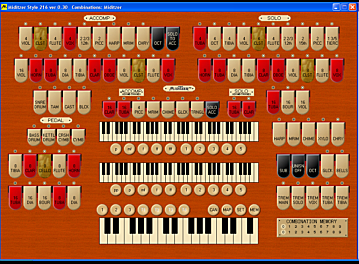| The
MiditzerTM Console Stops, part 1... |
|||
THE MIDITZER The Console Tech Session ELSEWHERE
|
The great range
of expressive power of an organ is due in large measure to the use of
stops to control the sound that will be produced by the keys. On
a pipe organ, every note is produced by a pipe. The pipes are
very much like whistles, producing a musical note when air is blown
into the pipe. In facts, organs are sometimes referred to
affectionately as a box of whistles. The pipes that play the very
high notes are just about the size of a toy whistle. In very
large organs, there may be pipes up to 32 feet long that produce
building shaking low notes. Pipes can be constructed of wood or metal in a variety of shapes to obtain a wide range of sound qualities. Theatre organs were designed to replace orchestras as musical accompaniment for silent movies, which never really were silent. The pipes in a theatre organ were chosen to provide sounds that are reminiscent of orchestral instruments such as flutes, violins, and oboes. For each sound provided there is a set of pipes, called a rank, that includes one pipe to make the particular sound for every note on the keyboard. Robert Hope-Jones, the genius behind so many of the revolutionary ideas that shaped theatre organs and made them different from classical organs,preferred to call his instrument a Unit Orchestra rather than an organ.
Classical organs
are generally provided with knobs that are pulled out to make a rank of
pipes active so that playing notes on the keyboard will cause the pipes
from that rank to play. Manipulating these draw knobs can be
cumbersome. Hope-Jones replaced the draw knows with a
semi-circular
arrangement of stop tabs that require only a quick flick of the finger
to turn on or off. They are more compact than draw knobs so many
more stop tabs can be placed within easy reach of the organist.
The tabs are color coded to make it easy for the organist to find the
desired stops quickly in dim light. The arrangement of the
colorful stop tabs provides the unmistakeable look of a "horseshoe
console" that is the signature of a theatre organ. Each stop is
associated with one of the keyboards. All the stops that affect a
keyboard are grouped together. The Miditzer screen has to take
great liberties with the stop tab layout to put usable controls on a
computer screen. The Miditzer recreates a Wurlitzer Style 216
organ. The main stop tabs are arranged in a single row on the
horseshoe with a row of shorter tabs below on the fallboard as seen in
this picture of a Style 216 console that was originally in the Rialto
Theatre in South Pasadena, California:
On the real
console the Pedal stops are at the left, the Accompaniment stops are in
the middle, and the Solo stops are to the right. If you compare
the Miditzer screen to the real console you may be able to spot the
color patterns to see how I folded up the stop rail to fit the screen.
Last
update 10/24/2004
© 2004 Jim Henry All Rights Reserved
|




